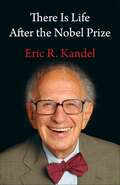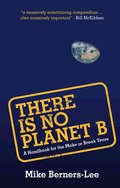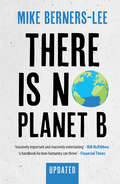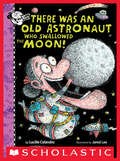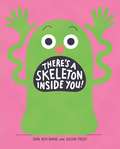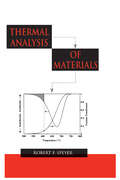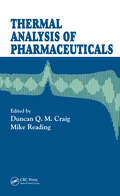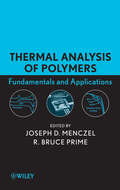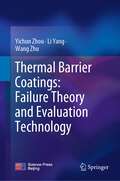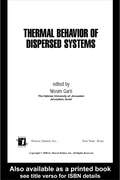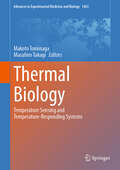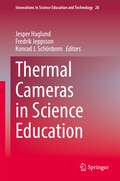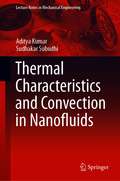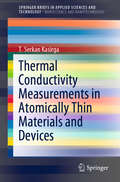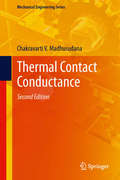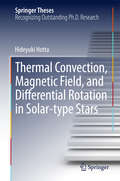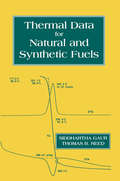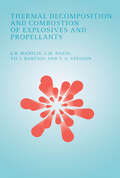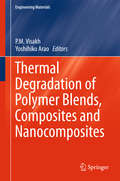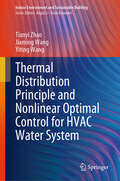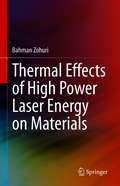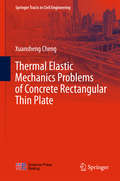- Table View
- List View
There Is Life After the Nobel Prize
by Eric KandelOne day in 1996, the neuroscientist Eric R. Kandel took a call from his program officer at the National Institute of Mental Health, who informed him that he had been awarded a key grant. Also, the officer said, he and his colleagues thought Kandel would win the Nobel Prize. “I hope not soon,” Kandel’s wife, Denise, said when she heard this. Sociologists had found that Nobel Prize winners often did not contribute much more to science, she explained.In this book, Kandel recounts his remarkable career since receiving the Nobel in 2000—or his experience of proving to his wife that he was not yet “completely dead intellectually.” He takes readers through his lab’s scientific advances, including research into how long-term memory is stored in the brain, the nature of age-related memory loss, and the neuroscience of drug addiction and schizophrenia. Kandel relates how the Nobel Prize gave him the opportunity to reach a far larger audience, which in turn allowed him to discover and pursue new directions. He describes his efforts to promote public understanding of science and to put brain science and art into conversation with each other. Kandel also discusses his return to Austria, which he had fled as a child, and observes Austria’s coming to terms with the Nazi period. Showcasing Kandel’s accomplishments, erudition, and wit, There Is Life After the Nobel Prize is a candid account of the working life of an acclaimed scientist.
There Is No Planet B: A Handbook for the Make or Break Years
by Mike Berners-LeeFeeding the world, climate change, biodiversity, antibiotics, plastics – the list of concerns seems endless. But what is most pressing, what are the knock-on effects of our actions, and what should we do first? Do we all need to become vegetarian? How can we fly in a low-carbon world? Should we frack? How can we take control of technology? Does it all come down to population? And, given the global nature of the challenges we now face, what on Earth can any of us do? Fortunately, Mike Berners-Lee has crunched the numbers and plotted a course of action that is practical and even enjoyable. There is No Planet B maps it out in an accessible and entertaining way, filled with astonishing facts and analysis. For the first time you'll find big-picture perspective on the environmental and economic challenges of the day laid out in one place, and traced through to the underlying roots - questions of how we live and think. This book will shock you, surprise you - and then make you laugh. And you'll find practical and even inspiring ideas for what you can actually do to help humanity thrive on this – our only – planet.
There Is No Planet B: A Handbook for the Make or Break Years – Updated Edition
by Mike Berners-LeeFeeding the world, climate change, biodiversity, antibiotics, plastics, pandemics - the list of concerns seems endless. But what is most pressing, and what should we do first? Do we all need to become vegetarian? How can we fly in a low-carbon world? How can we take control of technology? And, given the global nature of the challenges we now face, what on Earth can any of us do, as individuals? Mike Berners-Lee has crunched the numbers and plotted a course of action that is full of hope, practical, and enjoyable. This is the big-picture perspective on the environmental and economic challenges of our day, laid out in one place, and traced through to the underlying roots - questions of how we live and think. This updated edition has new material on protests, pandemics, wildfires, investments, carbon targets and of course, on the key question: given all this, what can I do?
There Was An Old Astronaut Who Swallowed the Moon! (There Was an Old Lady)
by Lucille ColandroScholastic's bestselling OLD LADY becomes an astronaut in this adventure full of hilarious laughs and fun facts about space -- perfect for the 50th anniversary of the moon landing!There was an old astronaut who swallowed the moon. I don't know why she swallowed the moon. It happened at noon.Scholastic's bestselling OLD LADY returns in this adventure series with a nonfiction twist that will make you laugh AND learn! In this spin-off, the OLD LADY turns into an OLD ASTRONAUT who travels through space, swallowing a moon... along with a star, a planet, a comet, a meteor, a rocket, and a satellite... Why? Well, it went down just right, that bright satellite! Two new characters lead the reader through this hilarious adventure while exchanging some awesome facts about outer space for a light take on nonfiction that's perfect for this age. With expanded back matter about the solar system and a search-and-find game at the end, this OLD ASTRONAUT definitely shoots for the stars!
There's No Place Like Space! All About Our Solar System: All About Our Solar System (The Cat in the Hat's Learning Library)
by Tish RabeLaugh and learn with fun facts about the sun, the moon, the planets, constellations, astronauts, and more—all told in Dr. Seuss&’s beloved rhyming style and starring The Cat in the Hat! &“The universe is a mysterious place. We are only just learning what happens in space.&” The Cat in the Hat&’s Learning Library series combines beloved characters, engaging rhymes, and Seussian illustrations to introduce children to non-fiction topics from the real world! On this adventure into outer space, readers will discover: • what makes each planet in our solar system unique• how a million Earths could fit inside the sun• how astronauts have driven a special car all over the moon• and much more! Perfect for story time and for the youngest readers, There&’s No Place Like Space: All About Our Solar System also includes an index, glossary, and suggestions for further learning. Look for more books in the Cat in the Hat&’s Learning Library series!Cows Can Moo! Can You? All About FarmsHark! A Shark! All About SharksIf I Ran the Dog Show: All About DogsOh Say Can You Say Di-no-saur? All About DinosaursOn Beyond Bugs! All About InsectsOne Vote Two Votes I Vote You VoteWho Hatches the Egg? All About EggsWhy Oh Why Are Deserts Dry? All About DesertsWish for a Fish: All About Sea Creatures
There's a Skeleton Inside You!
by Idan Ben-BarakFrom writer Idan Ben-Barak and illustrator Julian Frost, the creators of Do Not Lick This Book, comes a hilarious, interactive picture book that takes a look inside our bodies to show what humans are made of.Lay your hand flat out in front of you. Have you ever wondered what it's made of?What's beneath your skin?Your muscle?Your nerves?Find out in There's a Skeleton Inside You! Follow two friendly aliens named Quort and Oort as their spaceship breaks down on the way to their friend Kevin's birthday party. They realize they need a hand, but . . . they don't have hands! Don't worry. They have a great idea: They'll just grow some!What follows is an uproarious exploration of what makes up the human body, layer by layer.
Thermal Analysis of Materials (Materials Engineering)
by Robert SpeyerDiscussing the design and optimum use of thermal analysis instrumentation for materials' property measurement, this work details how the instruments work, what they measure, potential pitfalls and the fitting of experimental results to theoretical models. It presents a tutorial on writing computer programs for data manipulation, advanced thermoanal
Thermal Analysis of Pharmaceuticals
by Duncan Q. M. CraigAs a result of the Process Analytical Technologies (PAT) initiative launched by the U.S. Food and Drug Administration (FDA), analytical development is receiving more attention within the pharmaceutical industry. Illustrating the importance of analytical methodologies, Thermal Analysis of Pharmaceuticals presents reliable and versatile charac
Thermal Analysis of Polymers: Fundamentals and Applications
by Joseph D. Menczel R. Bruce PrimePresents a solid introduction to thermal analysis, methods, instrumentation, calibration, and application along with the necessary theoretical background. Useful to chemists, physicists, materials scientists, and engineers who are new to thermal analysis techniques, and to existing users of thermal analysis who wish expand their experience to new techniques and applications Topics covered include Differential Scanning Calorimetry and Differential Thermal Analysis (DSC/DTA), Thermogravimetry, Thermomechanical Analysis and Dilatometry, Dynamic Mechanical Analysis, Micro-Thermal Analysis, Hot Stage Microscopy, and Instrumentation. Written by experts in the various areas of thermal analysis Relevant and detailed experiments and examples follow each chapter.
Thermal Barrier Coatings: Failure Theory and Evaluation Technology
by Li Yang Yichun Zhou Wang ZhuThis book highlights the failure theories and evaluation techniques of thermal barrier coatings, covering the thermal-mechanical–chemical coupling theories, performance and damage characterization techniques, and related evaluations. Thermal barrier coatings are the key thermal protection materials for high-temperature components in advanced aeroengines. Coating spallation is a major technical bottleneck faced by researchers. The extremely complex microstructure, diverse service environments, and failure behaviors bring challenges to the spallation analysis in terms of the selective use of mechanical theories, experimental methods, and testing platforms. In the book, the authors provide a systematic summary of the latest research and technological advances and present their insights and findings in the past couple of decades. This book is not only suitable for researchers and engineers in thermal barrier coatings and related fields but also a good reference for upper-undergraduate and postgraduate students of materials science and mechanics majors.
Thermal Behavior of Dispersed Systems (Surfactant Science)
by Nissim Garti"Discusses the most recent advances in the correlations of structure and reactivity relationships of micelles, liposomes, microemulsions, and emulsions by thermal behavior measurements, as well as the options, scope, and limitations of the thermal behavior of dispersed systems. Highlights current studies on heterogeneous colloidal (dispersed) syste
Thermal Biology: Temperature Sensing and Temperature-Responding Systems (Advances in Experimental Medicine and Biology #1461)
by Makoto Tominaga Masahiro TakagiThis book concerns two subthemes, 'temperature sensing' and 'temperature-responding systems', addressing the questions of how temperature is sensed and how temperature is related to biological functions, respectively. Temperature affects various physiological functions and is one of the most important factors in homeostasis. The book seeks to integrate our understanding of temperature-dependent biological phenomena with the development of techniques that detect and regulate local temperatures in cells and organs with high resolution and precision. Part I: “Temperature sensing” addresses temperature sensing mechanisms by focusing on plasma membrane molecules, intracellular molecules and intracellular metabolic pathways. This part seeks to develop ways to detect and regulate local temperatures at a cellular level, which would facilitate future temperature- sensing research. Part II: “Temperature- responding systems” focuses on the neural circuits that integrate information concerning ambient temperature sensation, the effects of temperature on metabolic functions and biological rhythms, and mechanisms involved in emotion formation. This part clarifies crosstalk between temperature-responding systems by developing methods to detect and regulate local temperatures in organs. Authors of this book are leading researchers investigating temperature-sensing mechanisms across a wide range of biological responses from molecular to whole organism levels. The book promotes an integrated understanding of temperature-dependent biological phenomena under a novel discipline, 'thermal biology', which leads to a novel concept wherein 'temperature' as a physical quantity could be viewed as an element of new signaling mechanisms.
Thermal Cameras in Science Education (Innovations in Science Education and Technology #26)
by Jesper Haglund Fredrik Jeppsson Konrad J. SchönbornThis book presents a collection of educational research and developmental efforts on the rapidly emerging use of infrared cameras and thermal imaging in science education. It provides an overview of infrared cameras in science education to date, and of the physics and technology of infrared imaging and thermography. It discusses different areas of application of infrared cameras in physics, chemistry and biology education, as well as empirical research on students’ interaction with the technology. It ends with conclusions drawn from the contributions as a whole and a formulation of forward-looking comments.
Thermal Characteristics and Convection in Nanofluids (Lecture Notes in Mechanical Engineering)
by Aditya Kumar Sudhakar SubudhiThis book covers synthesis, characterization, stability, heat transfer and applications of nanofluids. It includes different types of nanofluids, their preparation methods as well as its effects on the stability and thermophysical properties of nanofluids. It provides a discussion on the mechanism behind the change in the thermal properties of nanofluids and heat transfer behaviour. It presents the latest information and discussion on the preparation and advanced characterization of nanofluids. It also consists of stability analysis of nanofluids and discussion on why it is essential for the industrial application. The book provides a discussion on thermal boundary layer properties in convection. Future directions for heat transfer applications to make the production and application of nanofluids at industrial level are also discussed.
Thermal Comfort Perception: A Questionnaire Approach Focusing on Children (Springerbriefs In Applied Sciences And Technology Ser.)
by Kristian FabbriThis book offers a comprehensive exploration of children's understanding and experiences of thermal comfort. The book provides a methodology for evaluating comfort that takes into account the unique perspectives of children. The first part of the book provides an overview of the history of thermal comfort, the human body and environmental parameters, and common thermal comfort indexes. It also offers guidelines for creating questionnaires that accurately assess children's perceptions of indoor thermal comfort. The book then delves into children's understanding of the concepts of comfort and energy, as well as the factors that influence their perception of these concepts. It addresses the psychological and pedagogical aspects of thermal comfort judgment, as well as the architectural and environmental characteristics that contribute to children's perceptions of comfort. First published as Indoor Thermal Comfort Perception, this updated edition also includes new sections on architecture and sensitivity, exploring the impact of classroom spaces on learning, and outdoor education and thermal comfort outdoors, based on qualitative research. These additions provide valuable insights for future studies on these topics. While physical parameter measurements and comfort indexes are useful in thermal comfort, the book emphasizes the importance of ergonomic assessments in the form of questionnaires, which offer unique insights into children's experiences. The book fills a critical gap in understanding children's perceptions of thermal comfort and is essential reading for HVAC engineers, architects, environmental psychologists, and researchers in the medical and cognitive fields.
Thermal Conductivity Measurements in Atomically Thin Materials and Devices (SpringerBriefs in Applied Sciences and Technology)
by T. Serkan KasirgaThis book assesses the thermal feasibility of using materials with atomically thin layers such as graphene and the transition metal dichalcogenides family in electronics and optoelectronics applications. The focus is on thermal conductivity measurement techniques currently available for the investigation of thermal performance at the material and device level. In addition to providing detailed information on the available techniques, the book introduces readers to novel techniques based on photothermal effects.
Thermal Contact Conductance
by Chakravarti V. MadhusudanaThe work covers both theoretical and practical aspects of thermal contact conductance. The theoretical discussion focuses on heat transfer through spots, joints, and surfaces, as well as the role of interstitial materials (both planned and inadvertent). The practical discussion includes formulae and data that can be used in designing heat-transfer equipment for a variety of joints, including special geometries and configurations. All of the material has been updated to reflect the latest advances in the field.
Thermal Convection, Magnetic Field, and Differential Rotation in Solar-type Stars
by Hideyuki HottaThis thesis describes the studies on the solar interior where turbulent thermal convection plays an important role. The author solved, for the first time, one of the long-standing issues in solar physics, i. e. , the maintenance mechanism of the solar differential rotation in the near-surface shear layer. The author attacked this problem with a newly developed approach, the reduced speed of sound technique, which enabled him to investigate the surface and deep solar layers in a self-consistent manner. This technique also made it possible to achieve an unprecedented performance in the solar convection simulations for the usage of the massively parallel supercomputers such as the RIKEN K system. It was found that the turbulence and the mean flows such as the differential rotation and the meridional circulation mutually interact with each other to maintain the flow structures in the Sun. Recent observations by helioseismology support the author's proposed theoretical mechanism. The book also addresses the generation of the magnetic field in such turbulent convective motions, which is an important step forward for solar cyclic dynamo research.
Thermal Data for Natural and Synthetic Fuels
by Siddhartha Gaur Thomas B. Reed"Presents 100 samples of organic substances characterized under identical conditions by thermogravimetry (TG) and differential thermal analysis (DTA) in addition to proximate analysis-providing accurate information essential in research and engineering applications related to fuel preparation. Discusses nonisothermal kinetic techniques, mathematical models, and other parameter estimation procedures that facilitate the extrapolation of results obtained under various conditions-including the Gaur and Reed method, an important advance in understanding the kinetics of thermal data!"
Thermal Decomposition and Combustion of Explosives and Propellants
by G.B. ManelisThis unique book investigates the synthesis, kinetics, and thermal decomposition properties and processing of energy-producing materials used in propellants, explosives, pyrotechnic, and gas-generating compositions. Thermal Decomposition and Combustion of Explosives and Propellants provides several mechanisms and stages for the thermal deco
Thermal Degradation of Polymer Blends, Composites and Nanocomposites
by P. M. Visakh Yoshihiko AraoThis book delivers a deep insight into thermal polymer degradation features and put a particular emphasis on blends, composites and nanocomposites. It examines the thermal stability and the mechanism of degrading for every class of polymer substances and studies the effect on reinforcement to all classes. The book further explores the thermal stability when nano particles are added and summarizes the latest studies and application relevant results. This book offers a valuable reference source to graduate and post graduate students, engineering students, research scholars and polymer engineers from industry.
Thermal Design
by H. S. LeeThe proposed is written as a senior undergraduate or the first-year graduate textbook,covering modern thermal devices such as heat sinks, thermoelectric generators and coolers, heat pipes, and heat exchangers as design components in larger systems. These devices are becoming increasingly important and fundamental in thermal design across such diverse areas as microelectronic cooling, green or thermal energy conversion, and thermal control and management in space, etc. However, there is no textbook available covering this range of topics. The proposed book may be used as a capstone design course after the fundamental courses such as thermodynamics, fluid mechanics, and heat transfer. The underlying concepts in this book cover the, 1) understanding of the physical mechanisms of the thermal devices with the essential formulas and detailed derivations, and 2) designing the thermal devices in conjunction with mathematical modeling, graphical optimization, and occasionally computational-fluid-dynamic (CFD) simulation. Important design examples are developed using the commercial software, MathCAD, which allows the students to easily reach the graphical solutions even with highly detailed processes. In other words, the design concept is embodied through the example problems. The graphical presentation generally provides designers or students with the rich and flexible solutions toward achieving the optimal design. A solutions manual will be provided.
Thermal Distribution Principle and Nonlinear Optimal Control for HVAC Water System (Indoor Environment and Sustainable Building)
by Tianyi Zhao Jiaming Wang Yiting WangThis book introduces the intelligent control technology of heating ventilation and air conditioning (HVAC) water system in detail, studying its thermal distribution characteristics and optimal control methods combining the nonlinearity, strong coupling and delay characteristics to improve the overall operation and maintenance level as well as the energy efficiency of HVAC water system. Intelligent control technology of HVAC water systems involves various fields such as electrical, mechanical, environmental and civil engineering. The book establishes a basic research framework for this topic using a sub-total approach, emphasizing the importance of thermodynamic properties and the significant influence of nonlinear properties in the optimal control of the system. This book is intended for undergraduate and postgraduate students interested in automated control of HVAC water systems, researchers investigating methods for system energy conservation and optimization and design engineers working on intelligent operation and maintenance of HVAC water system.
Thermal Effects of High Power Laser Energy on Materials
by Bahman ZohuriThis book offers a tutorial on the response of materials to lasers, with an emphasis on simple, intuitive models with analytical and mathematical solutions, using techniques such as Laplace Transformation to solve most complex heat conduction equations. It examines the relationship between existing thermal parameters of simple metals and looks at the characteristics of materials and their properties in order to investigate and perform theoretical analysis from a heat conduction perspective mathematically. Topics discussed include optical reflectivity of metals at infrared (IR) wavelengths, laser-induced heat flow in materials, the effects of melting and vaporization, the impulse generated in materials by pulsed radiation, and the influence of the absorption in the blow-off region in irradiated material. Written for engineers, scientists, and graduate-level engineering and physics students, Thermal Effects of High Power Laser Energy on Materials provides an in-depth look at high energy laser technology and its potential industrial and commercial applications in such areas as precision cutting, LIDAR and LADAR, and communications. The knowledge gained from this allows you to apply spaced-based relay mirror in order to compensate laser beam divergence back to its original coherency by preventing further thermal blooming that takes place during laser beam propagation through the atmosphere.Examines the state-of-the-art in currently available high energy laser technologies;Includes computer codes that deal with the response of materials to laser radiation;Provides detailed mathematical solutions of thermal response to laser radiation.
Thermal Elastic Mechanics Problems of Concrete Rectangular Thin Plate
by Xuansheng ChengThis book discusses the thermal-elastic mechanics problems of concrete rectangular thin plate. Using theoretical derivation combined with numerical examples, it explains in detail the analytical solution of the deflection, bending moment, thermal vibration and thermal buckling of concrete rectangular thin plate. To facilitate application, the book also includes deflection and bending moment calculation tables of concrete rectangular thin plate with four edges supported and with free boundary conditions.
